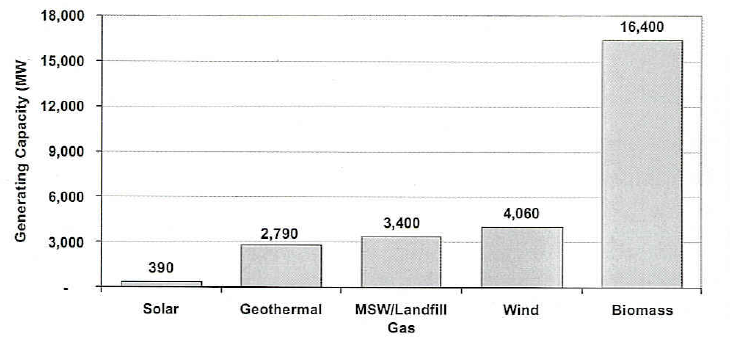What is Renewable Energy?
Renewable energy is result of natural atmospheric, geologic, and biological processes on the earth. Renewable energy sources include solar, wind, geothermal, and biomass. They are available in abundance in the western US and continually renew themselves, although they vary spatially and temporally within and between years. In other words, these energy sources cannot be depleted. Heat and light from the sun, wind, thermal gasses, and organic waste can all be harnessed to produce electricity, power machinery and automobiles, while working towards a cleaner environment, better air quality, and water use in comparison to traditional fossil fuel energy sources.
Just over 50% of the power used in the western US is generated with fossil fuels. Fossil fuels include coal, natural gas, and oil, all of which are non-renewable energy sources. These fuel sources will eventually be depleted, causing the costs of these sources to increase dramatically as supplies fall. There are many environmental and public health costs associated with non-renewable energy sources. Coal and gas extraction often necessitate land and natural environment degradation. Additionally, fossil fuels used to operate power plants and generate electricity produce 40% of total US carbon dioxide emissions, 63% of US sulfur dioxide emissions, and 20% of US nitrogen oxide emissions. The latter two of which cause urban haze, brown clouds, and acid rain.
Why is Renewable Energy Development Important?
In addition to the health and environmental benefits of renewable energy sources, there are also economic related benefits. Many renewable energy development projects are completed in rural areas, which may lead to economic development in terms of new business generation and employment opportunities. For example, wind farms that harness wind power and convert the power to electricity are often located in large open areas including rangeland, crop land, and mountain ridges. Additionally, renewable energy can provide reliable energy sources to rural areas where electricity was previously unreliable or unavailable.
Renewable energy may also reduce the long-term costs of power and stabilize energy prices due to its renewable nature. Market prices for energy as well as most other goods change in accordance with supply and demand. Renewable energy sources can provide a constant supply of energy, stabilizing energy prices. Studies show that renewable energy sources will need to be evaluated as a option in order to accommodate the increasing US population and its growing demand for energy in the western US.
Although the potential for renewable energy sources are great, there are many issues which must be addressed before these resources can be fully developed. These include, but are not limited to technology, transmission capabilities, and environmental impact studies.

The State of Nevada has abundant solar, wind, and biomass energy sources, but has more potential for geothermal energy production than any other state. In 2001, Nevada implemented the most aggressive renewable portfolio standard, calling for 15% of the state’s energy usage to come from renewable sources by 2013 (Senate Bill No. 372). This fact sheet is the third in a series of four publications, which provide an overview of renewable energy sources and current projects in Nevada, including resources for further information, and funding for renewable energy project development.
What is Biomass?
Biomass is defined as organic matter that is available on a renewable basis. For this publication biomass is referred to as the products produced by plants that convert sunlight into plant material through the process of photosynthesis. These types of biomass include forest and mill residues, agricultural crops and waste, wood and wood waste, animal waste, livestock operation residues, aquatic plants, fast-growing trees and plants, and municipal and industrial wastes. In short, any carbon based product that is grown utilizing land, water and sun resource can be classified as biomass. Biomass products are renewable resources, which can be replaced relatively quickly without permanently depleting the Earths natural resources. Biomass is utilized to provide energy in the form of electricity, heat, steam, and fuel.
Biomass is often partitioned into production categories. The first is municipal and industrial waste. The products generated in this area include materials provided to landfills and products generated by the forest products industry. The second is agricultural and rangeland crop residue. Basically all crops and rangeland plant products, whether used for food, animal feed, or fiber and by products thereof, can be considered as a biomass source. The entire product can be used or the resulting residue from the product once the primary use is fulfilled. A common example is grain products. Once the primary product is harvested, such as the wheat or corn, the resulting straw, chaff, stalk, or other secondary products can be utilized as biomass in energy production.
When evaluating products suitable for energy use, two factors are often considered. First, the product must have a high yield of dry matter per unit of land area. Often this is calculated on a total dry matter per ton/acre basis. High dry matter production on a per acre basis lowers the total land area needed and will lower the per land unit production cost. Second, the amount of energy resulting from the production of the crop must be more than the amount of energy required to produce the crop.
How is Biomass Energy Derived?
The most common and often simplest and/or cheapest method of deriving energy from biomass is direct combustion. Any biomass product with a low water content (i.e. high dry matter), allowing for sustainable combustion, can be burned to produce energy. The heat generated from this biomass burning is then used for space, processing, or water heating in a steam turbine to generate electricity.
Biomass can be converted to energy through several processes, which result in power, heat, steam, or fuel. These include co-firing, where biomass products fuel between 1% and 15% of the energy requirements of a coal electricity generation plant. Biomass can be used in a conventional steam boiler where heat creates steam to run a turbine. On a larger scale, power plants utilize biomass steam and heat in a process called Combined Heat and Power (CHP), resulting in improved production efficiencies of over 35%.

Biomass gasification converts biomass to a gaseous form, which then can be used to power a gas turbine or other power unit. Anaerobic digestion is a process in which bacteria in an anaerobic environment, converts the biomass into methane gas that can be utilized to power gas turbines or fuel cells. Biomass fuels can be a substitute for fossil fuels, used to power engines, cars, diesel generators, and industrial operations. The process of converting biomass into useable fuels includes both biochemical and thermal conversions to produce gaseous, liquid, and solid fuels with high energy content, ease of transportation for users, and suitable as a commercial fuel source.
Biochemical conversion of biomass products is accomplished by alcoholic fermentation to produce liquid fuels, and anaerobic digestion or fermentation to generate biogas. Alcoholic fermentation of grain crops such as corn and wheat, results in a product known as ethanol, which can be used in internal combustion engines.
Thermochemical processing of products containing lignin and cellulose, such as wood waste, agricultural by products, nut hulls, etc. is used to convert the products into solid liquid and gaseous fuels. Pyrolysis, the process used to produce charcoal is the most common. During this process the biomass is heated in the absence of air and breaks down into complex mixtures of gases, liquids, and char. Current technologies allow this process to utilize the break down products for energy development.
Households use biomass as an energy source in fireplaces and kilns for heating and cooking. Anaerobic digestion of biomass products is a process where methane and carbon dioxide are derived from the organic fraction of sewage sludge, animal wastes and industrial effluents. The resulting clean burning fuel can then be used as an energy source for cooking, heating, or electrical generation.
As can be seen in Figure 1 on page 4, as of 2001, the biomass energy generating capacity in the US is higher than any other non-hydro renewable energy source.
Figure 1. U.S. Non-Hydro Renewable Power Generating Capacity, 2001

Data From Figure 1
What is the Status of Biomass in Nevada?
As can be seen in Figure 1 on page 4, as of 2001, the biomass energy generating capacity in the US is higher than any other non-hydro renewable energy source. In Nevada, many projects for expanding energy generation through the use of biomass are underway. In 2004, the Nevada Fire Safe Council in cooperation with the Nevada Department of Economic Development provided funding to research biomass availability within a 50 mile radius of Carson City, NV. State and local entities were interested in evaluating the amount of material available to fuel both public and private alternative energy projects. Biomass products in this area are currently being used to create pellets which are then burned in pellet wood stoves and marketed in the west. Additionally, biomass supply is being evaluated as an option for heating/cooling systems in proposed hospital and prison building projects.
In Ely, NV, a “fuels for schools” project is currently under evaluation. This project examines the use of biomass from pinyon and juniper trees and waste from range improvement projects to heat/cool public schools in White Pine County.
Public and private entities, including the University of Nevada Reno University system are evaluating crops that may be suitable for commercial biomass production. In addition these entities are evaluating the economic viability of such crops.
Where Can I Find Funding for Biomass Projects?
USDA-Rural Development: This grant authorized by the 2002 Farm Bill, provided funds ($22.8 million in 2004) to rural ranchers, farmers, and small business for renewable energy projects, including wind, solar, biomass, and geothermal sources. Grant funds, which can be used for up to 25% of total project costs, are awarded annually.
USDA-SBIR: Community development grants to small business for new technology studies, market and feasibility studies.
Rebate Programs
There are a number of rebate programs in Nevada, including business and personal property tax rebates, sales tax rebates, and utility bill rebates. The Federal Government also provides rebates including corporate tax credits such as the business energy tax credit of 10% available to commercial businesses that invest in solar or geothermal equipment and structures. A complete listing of all State and Federal programs is available at Dsireusa.
Where Can I Find Additional Information?
Web Resources
Nevada State Office of Energy
Biomass Energy Research Association
National Renewable Energy Laboratory
American Bioenergy Association
Nevada Biomass Working Group:
John McLain at Resource Concepts Inc.
Contractors/Providers
McNeil Technologies, Inc.
143 Union Blvd., Suite 900
Lakewood, CO 80228
References
Clean Energy Choices, U.S. Department of Energy, Office of Energy and Efficiency and Renewable Energy. October 2001.
Nielson, John, Susan Innis, Leslie Kaas Pollock, Heather Rhoads-Weaver, and Angela Shutak. Renewable Energy Atlas of the West: A Guide to the Region’s Resource Potential. A project of the Hewlett Foundation and The Energy Foundation. Produced by Land and Water Fund of the Rockies and Northwest Sustainable Energy for Economic Development.
Renewable Energy Policy Project and Center for Renewable Energy and Sustainable Technology, Bioenergy Facts.
This project is sponsored in part by the University of Nevada Cooperative Extension, the University of Nevada Agricultural Experiment Station, and the Nevada State Office of Energy.
Source: EIA Renewable ENergy Annual 2001. Biomass excludes agriculture byproducts/crops, sludge waste, tires, and other biomass solids, liquids and gases.


